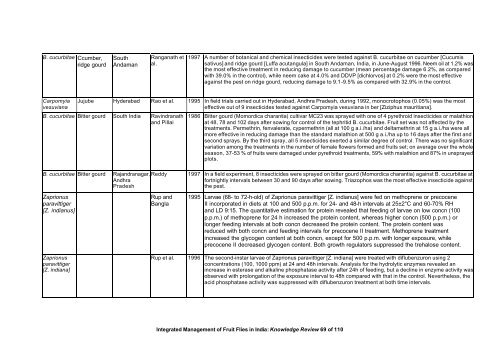“Key Informant Survey” of Production, Value, Losses and ... - DfID
“Key Informant Survey” of Production, Value, Losses and ... - DfID
“Key Informant Survey” of Production, Value, Losses and ... - DfID
Create successful ePaper yourself
Turn your PDF publications into a flip-book with our unique Google optimized e-Paper software.
B. cucurbitae Ccumber,<br />
ridge gourd<br />
Carpomyia<br />
vesuviana<br />
South<br />
Andaman<br />
Ranganath et<br />
al.<br />
1997 A number <strong>of</strong> botanical <strong>and</strong> chemical insecticides were tested against B. cucurbitae on cucumber [Cucumis<br />
sativus] <strong>and</strong> ridge gourd [Luffa acutangula] in South Andaman, India, in June-August 1996. Neem oil at 1.2% was<br />
the most effective treatment in reducing damage to cucumber (mean percentage damage 6.2%, as compared<br />
with 39.0% in the control), while neem cake at 4.0% <strong>and</strong> DDVP [dichlorvos] at 0.2% were the most effective<br />
against the pest on ridge gourd, reducing damage to 9.1-9.5% as compared with 32.9% in the control.<br />
Jujube Hyderabad Rao et al. 1995 In field trials carried out in Hyderabad, Andhra Pradesh, during 1992, monocrotophos (0.05%) was the most<br />
effective out <strong>of</strong> 9 insecticides tested against Carpomyia vesuviana in ber [Ziziphus mauritiana].<br />
B. cucurbitae Bitter gourd South India Ravindranath<br />
<strong>and</strong> Pillai<br />
B. cucurbitae Bitter gourd Raj<strong>and</strong>ranagar,<br />
Andhra<br />
Pradesh<br />
Zaprionus<br />
paravittiger<br />
[Z. indianus]<br />
Zaprionus<br />
paravittiger<br />
[Z. indiana]<br />
1986 Bitter gourd (Momordica charantia) cultivar MC23 was sprayed with one <strong>of</strong> 4 pyrethroid insecticides or malathion<br />
at 48, 78 <strong>and</strong> 102 days after sowing for control <strong>of</strong> the tephritid B. cucurbitae. Fruit set was not affected by the<br />
treatments. Permethrin, fenvalerate, cypermethrin (all at 100 g a.i./ha) <strong>and</strong> deltamethrin at 15 g a.i./ha were all<br />
more effective in reducing damage than the st<strong>and</strong>ard malathion at 500 g a.i./ha up to 16 days after the first <strong>and</strong><br />
second sprays. By the third spray, all 5 insecticides exerted a similar degree <strong>of</strong> control. There was no significant<br />
variation among the treatments in the number <strong>of</strong> female flowers formed <strong>and</strong> fruits set; on average over the whole<br />
season, 37-53 % <strong>of</strong> fruits were damaged under pyrethroid treatments, 59% with malathion <strong>and</strong> 87% in unsprayed<br />
plots.<br />
Reddy 1997 In a field experiment, 8 insecticides were sprayed on bitter gourd (Momordica charantia) against B. cucurbitae at<br />
fortnightly intervals between 30 <strong>and</strong> 90 days after sowing. Triazophos was the most effective insecticide against<br />
the pest.<br />
Rup <strong>and</strong><br />
Bangla<br />
1995 Larvae (68- to 72-h-old) <strong>of</strong> Zaprionus paravittiger [Z. indianus] were fed on methoprene or precocene<br />
II incorporated in diets at 100 <strong>and</strong> 500 p.p.m. for 24- <strong>and</strong> 48-h intervals at 25±2°C <strong>and</strong> 60-70% RH<br />
<strong>and</strong> LD 9:15. The quantitative estimation for protein revealed that feeding <strong>of</strong> larvae on low concn (100<br />
p.p.m.) <strong>of</strong> methoprene for 24 h increased the protein content, whereas higher concn (500 p.p.m.) or<br />
longer feeding intervals at both concn decreased the protein content. The protein content was<br />
reduced with both concn <strong>and</strong> feeding intervals for precocene II treatment. Methoprene treatment<br />
increased the glycogen content at both concn, except for 500 p.p.m. with longer exposure, while<br />
precocene II decreased glycogen content. Both growth regulators suppressed the trehalose content.<br />
Rup et al. 1996 The second-instar larvae <strong>of</strong> Zaprionus paravittiger [Z. indiana] were treated with diflubenzuron using 2<br />
concentrations (100, 1000 ppm) at 24 <strong>and</strong> 48h intervals. Analysis for the hydrolytic enzymes revealed an<br />
increase in esterase <strong>and</strong> alkaline phosphatase activity after 24h <strong>of</strong> feeding, but a decline in enzyme activity was<br />
observed with prolongation <strong>of</strong> the exposure interval to 48h compared with that in the control. Nevertheless, the<br />
acid phosphatase activity was suppressed with diflubenzuron treatment at both time intervals.<br />
Integrated Management <strong>of</strong> Fruit Flies in India: Knowledge Review 69 <strong>of</strong> 110

















